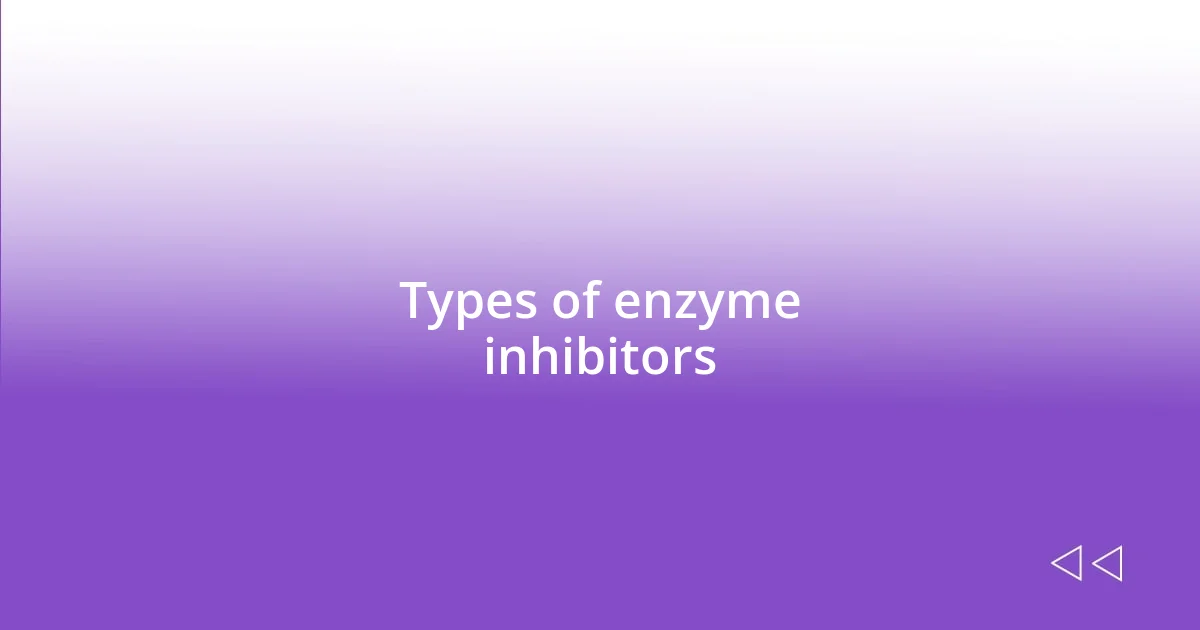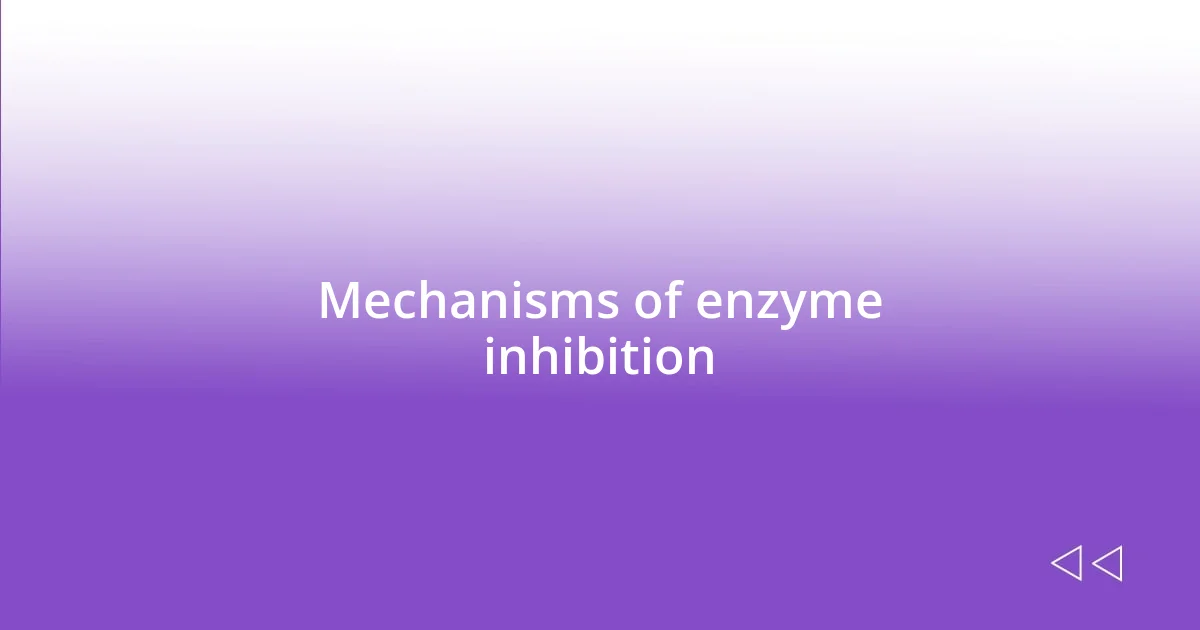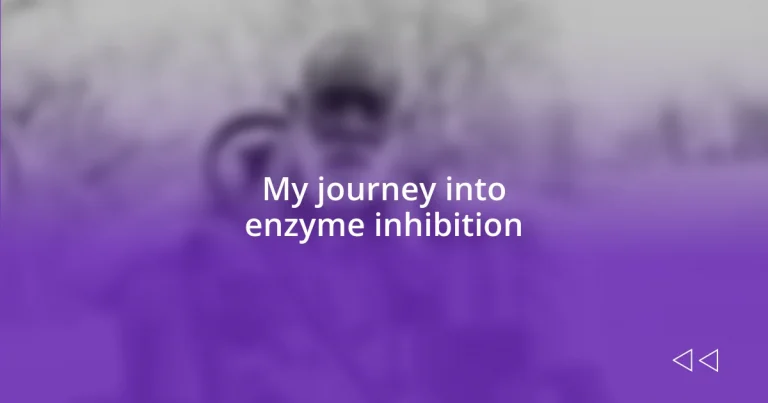Key takeaways:
- Understanding enzyme inhibition, both competitive and non-competitive, is essential for drug design and disease management.
- Enzymes lower activation energy and operate with specificity, essential for efficient metabolic processes, often working in coordinated multienzyme complexes.
- Measuring enzyme inhibition through various techniques is crucial for developing effective enzyme inhibitors, highlighting the significance of collaboration across scientific disciplines in drug development.

Understanding enzyme inhibition
Enzyme inhibition is a fascinating concept that plays a critical role in biochemistry. I still remember the moment when I first grasped how a molecule could bind to an enzyme and prevent it from functioning effectively. It felt like uncovering a secret that explained why certain reactions stall in living organisms. Have you ever wondered why certain medications are so effective? It turns out that many of them work by inhibiting enzymes involved in specific metabolic pathways.
This inhibition can be competitive or non-competitive. Competitive inhibition occurs when an inhibitor resembles the substrate and competes for the active site. I always find it intriguing to think about how this mimicry can effectively “block” the natural process. On the other hand, non-competitive inhibition occurs when the inhibitor binds to a site other than the active site, thereby altering the enzyme’s shape and function. Picture a key that can still fit into a lock but doesn’t turn, leaving you frustrated. Isn’t it fascinating how different types of inhibition can drastically alter metabolic processes?
The implications of enzyme inhibition are vast. For instance, in drug design, understanding how inhibitors interact with specific enzymes can lead to more effective treatments. I often think about the impact on disease management—how a deeper understanding of enzyme inhibition could lead to breakthroughs in fighting illnesses. It expands the way we view not just enzymes, but the entire biological landscape, making every little interaction count in the grand scheme of our metabolic journeys.

Role of enzymes in biology
Enzymes are often described as the workhorses of biology, catalyzing chemical reactions that are essential for life. I remember my own “aha” moment when I learned how enzymes lower the activation energy of reactions, making processes that could take eons occur in seconds. This efficiency is crucial; without enzymes, our metabolic pathways would grind to a halt, and life as we know it would be unsustainable.
As I explored this topic further, I realized that the specificity of enzymes is just as vital as their speed. Each enzyme is like a lock with a unique key, designed to interact with a specific substrate. It’s a mesmerizing thought that every biochemical reaction in our body is tailored by nature for optimal performance, shaping everything from digestion to DNA replication. Have you ever considered how a slight change in temperature or pH can denature an enzyme, rendering it ineffective? I find that interplay between environmental factors and enzyme activity incredibly fascinating and critical for maintaining homeostasis.
Enzymes not only facilitate individual reactions but also coordinate complex metabolic networks. My interest once piqued when I learned that enzymes work in teams, often referred to as multienzyme complexes, to streamline pathways. It’s like a well-orchestrated dance, where each enzyme knows its role, ensuring that the body functions smoothly and efficiently. This intricate choreography of biochemical reactions is a testament to the elegance of life itself.
| Enzyme Role | Description |
|---|---|
| Catalysis | Lower activation energy to speed up reactions |
| Specificity | Interact with specific substrates like keys in locks |
| Coordination | Work together in metabolic pathways for efficiency |

Types of enzyme inhibitors
Enzyme inhibitors come in various forms, each with its unique method of interfering with enzyme function. Reflecting on my own journey, I was initially amazed at how understanding these types did not just unveil the mechanics of biochemical reactions but also exposed the artistry of biochemical regulation. For example, there are irreversible inhibitors that form permanent bonds with enzymes, much like a couple tying the knot; once bound, there’s no going back! In contrast, reversible inhibitors are more like a brief encounter — they can attach and detach from enzymes, allowing for a dynamic control of metabolic pathways.
Here’s a quick breakdown of the main types of enzyme inhibitors:
- Competitive Inhibitors: These resemble substrates and compete for the active site, effectively blocking the natural substrate from binding.
- Non-competitive Inhibitors: They bind to a different site on the enzyme, causing a change in shape and function without competing with the substrate.
- Irreversible Inhibitors: These make permanent alterations by binding covalently, leading to a long-lasting impact on enzyme activity.
- Allosteric Inhibitors: They bind to an allosteric site, changing the enzyme’s structure and reducing its activity even if the substrate is present.
In investigating these different types, I can’t help but recall the first time I utilized inhibitors in a lab. It was a revelation to see how the addition of a competitive inhibitor drastically changed reaction rates, highlighting the delicate balance of life. This really hits home the importance of enzyme inhibitors not only in research but also in drug development, where the right type of inhibition can mean the difference between healing and harmful side effects. It stirs a sense of wonder about the intricacies of our biological systems and how they can be manipulated for therapeutic purposes.

Mechanisms of enzyme inhibition
The mechanisms of enzyme inhibition are as intriguing as they are diverse. When I first delved into how competitive inhibitors function, it hit me how these molecules can mimic substrates, vying for the active site and effectively blocking the genuine substrate. It’s like watching a game of musical chairs, where one player manages to claim the seat while the real contender is left standing. This dynamic interaction made me realize how subtle changes can impact our biochemistry significantly.
Then there’s the more nuanced role of non-competitive inhibitors, which taught me that sometimes it’s not about competing directly. These inhibitors can bind elsewhere on the enzyme, changing its shape and reducing activity without even touching the active site. I remember thinking how life’s complexities mirror this mechanism; often, problems arise not from direct confrontation but from underlying influences that alter the entire structure of the situation. It’s fascinating how biochemistry can reflect broader life lessons, don’t you think?
Allosteric inhibition added another layer to my understanding. These inhibitors change the enzyme’s conformation from a distance, like a conductor guiding an orchestra, affecting its ability to perform. I vividly recall a lab experiment where, upon adding an allosteric inhibitor, the entire reaction pathway shifted, highlighting how delicately balanced our metabolic processes are. The realization that tiny molecules could have such profound effects stirred a mix of admiration and fascination in me, turning my perspective on enzyme regulation into something deeply personal and relatable.

Techniques for measuring inhibition
Measuring enzyme inhibition is crucial for understanding the intricate dance between enzymes and their inhibitors. I remember one of my first experiences working in a lab where we employed spectrophotometry to gauge reactions. The changes in light absorption were striking, revealing just how effectively an inhibitor could halt the activity of an enzyme. It made me appreciate how these methods serve not just as tools, but as windows into the biochemical interactions we seek to understand.
Another technique that caught my attention was the use of kinetic assays to determine the type of inhibition. By analyzing how reaction rates varied with different substrate concentrations, I often found myself reflecting on the power of real-time data. For instance, when working with a competitive inhibitor, I could practically see the tug-of-war between the inhibitor and substrate. It was exhilarating to gather data that painted a clear picture of the dynamics at play and to visualize the role each participant had in the reaction.
I also had the chance to explore fluorescence-based assays, which introduced a different layer of excitement. Watching enzymes fluoresce or quench in response to inhibitor presence felt almost like magic. It was a vivid reminder of how deeply connected we are to these microscopic interactions, despite their often-invisible nature. Such experiences have reinforced my belief that adequately measuring inhibition doesn’t just advance scientific understanding; it personalizes the story of life at the molecular level. Isn’t it remarkable how these techniques can illuminate such fundamental processes?

Applications in drug development
The applications of enzyme inhibition in drug development are vast and dynamic. I remember when I first learned about the pivotal role of inhibitors in designing therapeutics; the realization that many modern drugs are essentially enzyme inhibitors was eye-opening. It’s fascinating to think that simple molecules can stand between illness and health by inhibiting critical biological pathways. Each time I reflected on this process, I felt a thrill knowing how our understanding of enzymes translates into tangible treatments for diseases like cancer and Alzheimer’s.
In my experience, finding selectivity in enzyme inhibition is crucial in drug design. During a project on developing inhibitors for specific enzymes, I discovered how fine-tuning an inhibitor’s structure could make it more effective and less toxic. It was surprising to see how slight modifications could yield profound differences in a drug’s efficacy. This process is much like perfecting a recipe; even a pinch too much of an ingredient can change the final dish. Have you ever tried tweaking a recipe only to find it turned out completely different? The stakes in drug design feel much higher, but the core idea is the same: small changes can lead to significantly better outcomes.
Moreover, I often think about how the journey of drug development underscores the importance of collaborations across disciplines. While working alongside chemists, biologists, and pharmacologists, I was struck by how our varied approaches came together to create effective enzyme inhibitors. It felt like being part of a puzzle where each piece, with its unique shape, was necessary to complete the picture. This experience reinforced my belief that collective efforts in understanding enzyme mechanisms can lead to breakthroughs that improve lives. Isn’t it incredible how diverse expertise can unlock new pathways in medicine?

My personal experiences and insights
As I delved deeper into enzyme inhibition, I encountered a fascinating moment during a team meeting where we were discussing our findings on a particularly stubborn enzyme. I remember feeling a mix of frustration and excitement when my colleague suggested an unconventional inhibitor. It struck me then how science often thrives on creativity, just as much as it relies on strict methodologies. Have you ever felt that spark of inspiration when the answer seemed just out of reach? I know I have, and it’s these moments that truly keep us going.
Another experience that stands out to me is when I had the chance to present our work at a conference. Standing in front of fellow scientists, sharing insights on our latest inhibitor development, gave me a rush of adrenaline. I could sense the genuine interest from the audience; their questions challenged me to think even further beyond our findings. This interaction reminded me that sharing our journey doesn’t just advance our knowledge but can also ignite curiosity and collaboration in others. Isn’t it amazing how a simple discussion can lead to new ideas and innovations?
Reflecting on my journey, I often think about the human aspect of enzyme inhibition research. Working late in the lab, surrounded by colleagues who shared both the burdens and joys of discovery, fostered a real sense of camaraderie. I’ve grown to appreciate how each failed experiment was just as valuable as the successes; they shaped our understanding and resilience. Have you ever engaged in a project that didn’t go as planned but ended up teaching you something invaluable? For me, those lessons led to a deeper passion for what we do and an enduring commitment to pushing the boundaries of science.














